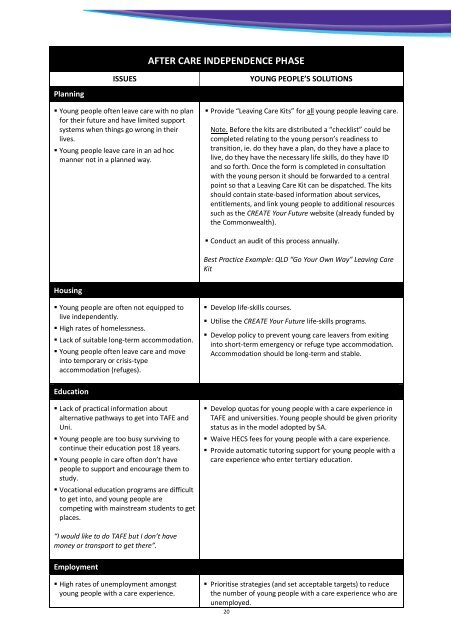What's the Answer? - Create
What's the Answer? - Create
What's the Answer? - Create
Create successful ePaper yourself
Turn your PDF publications into a flip-book with our unique Google optimized e-Paper software.
PlanningISSUESAFTER CARE INDEPENDENCE PHASEYOUNG PEOPLE’S SOLUTIONS• Young people often leave care with no planfor <strong>the</strong>ir future and have limited supportsystems when things go wrong in <strong>the</strong>irlives.• Young people leave care in an ad hocmanner not in a planned way.• Provide “Leaving Care Kits” for all young people leaving care.Note. Before <strong>the</strong> kits are distributed a “checklist” could becompleted relating to <strong>the</strong> young person’s readiness totransition, ie. do <strong>the</strong>y have a plan, do <strong>the</strong>y have a place tolive, do <strong>the</strong>y have <strong>the</strong> necessary life skills, do <strong>the</strong>y have IDand so forth. Once <strong>the</strong> form is completed in consultationwith <strong>the</strong> young person it should be forwarded to a centralpoint so that a Leaving Care Kit can be dispatched. The kitsshould contain state-based information about services,entitlements, and link young people to additional resourcessuch as <strong>the</strong> CREATE Your Future website (already funded by<strong>the</strong> Commonwealth).• Conduct an audit of this process annually.Best Practice Example: QLD “Go Your Own Way” Leaving CareKitHousing• Young people are often not equipped tolive independently.• High rates of homelessness.• Lack of suitable long-term accommodation.• Young people often leave care and moveinto temporary or crisis-typeaccommodation (refuges).• Develop life-skills courses.• Utilise <strong>the</strong> CREATE Your Future life-skills programs.• Develop policy to prevent young care leavers from exitinginto short-term emergency or refuge type accommodation.Accommodation should be long-term and stable.Education• Lack of practical information aboutalternative pathways to get into TAFE andUni.• Young people are too busy surviving tocontinue <strong>the</strong>ir education post 18 years.• Young people in care often don’t havepeople to support and encourage <strong>the</strong>m tostudy.• Vocational education programs are difficultto get into, and young people arecompeting with mainstream students to getplaces.• Develop quotas for young people with a care experience inTAFE and universities. Young people should be given prioritystatus as in <strong>the</strong> model adopted by SA.• Waive HECS fees for young people with a care experience.• Provide automatic tutoring support for young people with acare experience who enter tertiary education.“I would like to do TAFE but I don’t havemoney or transport to get <strong>the</strong>re”.Employment• High rates of unemployment amongstyoung people with a care experience.• Prioritise strategies (and set acceptable targets) to reduce<strong>the</strong> number of young people with a care experience who areunemployed.20




![pdf [107kB] - Department of Families, Housing, Community Services](https://img.yumpu.com/51272499/1/190x245/pdf-107kb-department-of-families-housing-community-services.jpg?quality=85)










![Land Claim - pdf [278kB] - Department of Families, Housing ...](https://img.yumpu.com/47002639/1/184x260/land-claim-pdf-278kb-department-of-families-housing-.jpg?quality=85)

![Borroloola Land Claim - pdf [299kB] - Department of Families ...](https://img.yumpu.com/46103973/1/184x260/borroloola-land-claim-pdf-299kb-department-of-families-.jpg?quality=85)